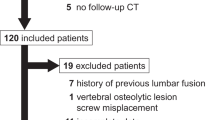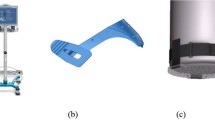Abstract
Purpose
The favored treatment for many hip fractures is a sliding hip screw, and its usage is expected to increase in the future. Failures can be reduced, and complications detected earlier by semi-automated CT image analysis. The most frequent failure is due to the screw cut-out from the femoral head.
Methods
An image-based method was developed for early detection of complications and assessment of anchorage quality relative to implant model, bone quality or tip-apex distance (TAD). This method evaluates micro-migration using CT images acquired at different time points (immediately post-op and 3-month later). Serial CT image registration and transformation methods were applied, including point-based registration, to achieve semi-automated evaluations.
Results
Qualitative and quantitative validation of the image registration was performed with measurement mean error determination by different observers. The micro-migration evaluation by clinicians compared favorably with semi-automated image-based results.
Conclusion
Semi-automatic evaluation of hip screw micro-migration using CT images is feasible and can aid observation of convalescence. The method may be amenable to full automation, a future goal for this work.
Similar content being viewed by others
References
Cummings SR, Rubin SM, Black D (1990) The future of hip fractures in the United States. Numbers, costs, and potential effects of postmenopausal estrogen. Clin Orthop Relat Res 252: 163–166
Baumgaertner MR, Curtin SL, Lindskog DM, Keggi JM (1995) The value of the tip-apex distance in predicting failure of fixation of peritrochanteric fractures of the hip. J Bone Joint Surg Am 77(7): 1058–1064
Bannister GC, Gibson AG, Ackroyd CE, Newman JH (1990) The fixation and prognosis of trochanteric fractures. A randomized prospective controlled trial. Clin Orthop Relat Res 254: 242–246
Simpson AH, Varty K, Dodd CA (1989) Sliding hip screws: modes of failure. Injury 20: 227–231
Wolfgang GL, Bryant MH, O’Neill JP (1982) Treatment of intertrochanteric fracture of the femur using sliding screw plate fixation. Clin Orthop Relat Res 163: 148–158
Hsueh K, Fang C, Chen C, Su Y, Wu H, Chiu F (2009) Risk factors in cutout of sliding hip screw in intertrochanteric fractures: an evaluation of 937 patients. Int Orthop. doi:10.1007/s00264-009-0866-2
Kyle RF, Gustilo RB, Premer RF (1979) Analysis of six hundred and twenty-two intertrochanteric hip fractures. J Bone Joint Surg Am 61(2): 216–221
Pervez H, Parker MJ, Vowler S (2004) Prediction of fixation failure after sliding hip screw fixation. Injury 35: 994–998
Zitová B, Flusser J (2003) Image registration methods: a survey. Image Vis Comput 21: 977–1000
Besl PJ, McKay ND (1992) A method for registration of 3-D shapes. IEEE Trans Pattern Anal Mach Intell 14(2): 239–256
Yoo TS, Ackerman MJ, Lorensen WE, Schroeder W, Chalana V, Aylward S et al (2002) Engineering and algorithm design for an image processing Api: a technical report on ITK–the Insight Toolkit . Stud Health Technol Inform 85: 586–592
Lorensen WE, Cline HE (1987) Marching cubes: a high resolution 3D surface construction algorithm. Computer Graphics 21(4): 163–169
Fitzgibbon AW (2003) Robust registration of 2D and 3D point sets. Image Vis Comput 21: 1145–1153
Levenberg K (1944) A method for the solution of certain non-linear problems in least squares. Q Appl Math 2: 164–168
Author information
Authors and Affiliations
Corresponding author
Rights and permissions
About this article
Cite this article
Raudaschl, P., Fritscher, K., Roth, T. et al. Analysis of the micro-migration of sliding hip screws by using point-based registration. Int J CARS 5, 455–460 (2010). https://doi.org/10.1007/s11548-010-0498-4
Received:
Accepted:
Published:
Issue Date:
DOI: https://doi.org/10.1007/s11548-010-0498-4




